Organisational Behaviour Report: Analysis of 4Com plc's Dynamics
VerifiedAdded on 2020/06/06
|16
|4753
|422
Report
AI Summary
This report delves into the realm of organisational behaviour, examining its impact on the workforce of 4Com plc, a telecommunications company. The report begins by analyzing the influence of culture, politics, and power dynamics on individual behaviour within the organisation, highlighting both the advantages and disadvantages of these factors. It then evaluates various process and content theories of motivation, including Maslow's hierarchy of needs, Herzberg's two-factor theory, and McGregor's Theory X and Y, to understand how employee motivation can be effectively managed. Furthermore, the report explores the features of an effective team and applies concepts and philosophies of organisational behaviour to different business circumstances. The report concludes with a summary of the key findings and insights gained from the analysis of organisational behaviour principles within the context of 4Com plc.
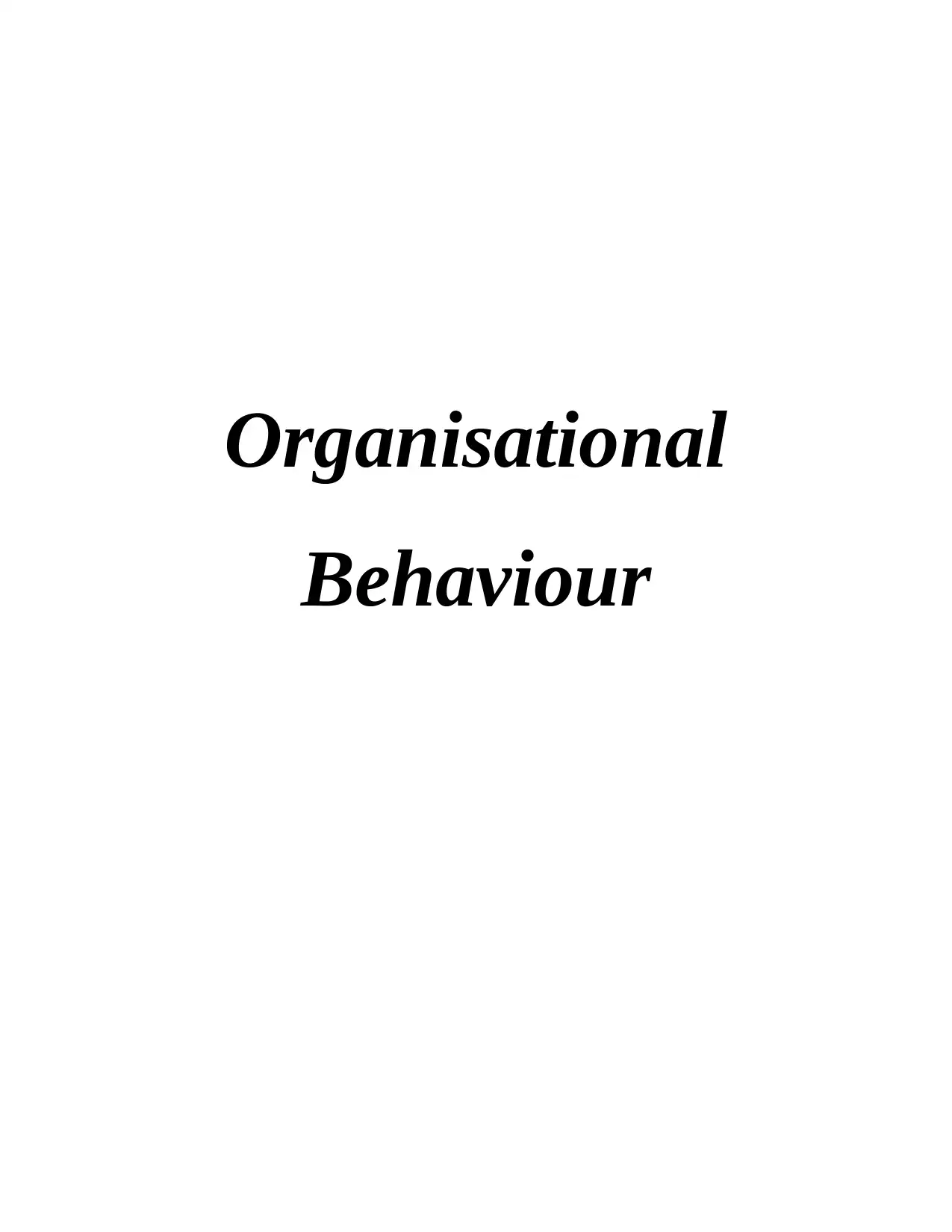
Organisational
Behaviour
Behaviour
Paraphrase This Document
Need a fresh take? Get an instant paraphrase of this document with our AI Paraphraser
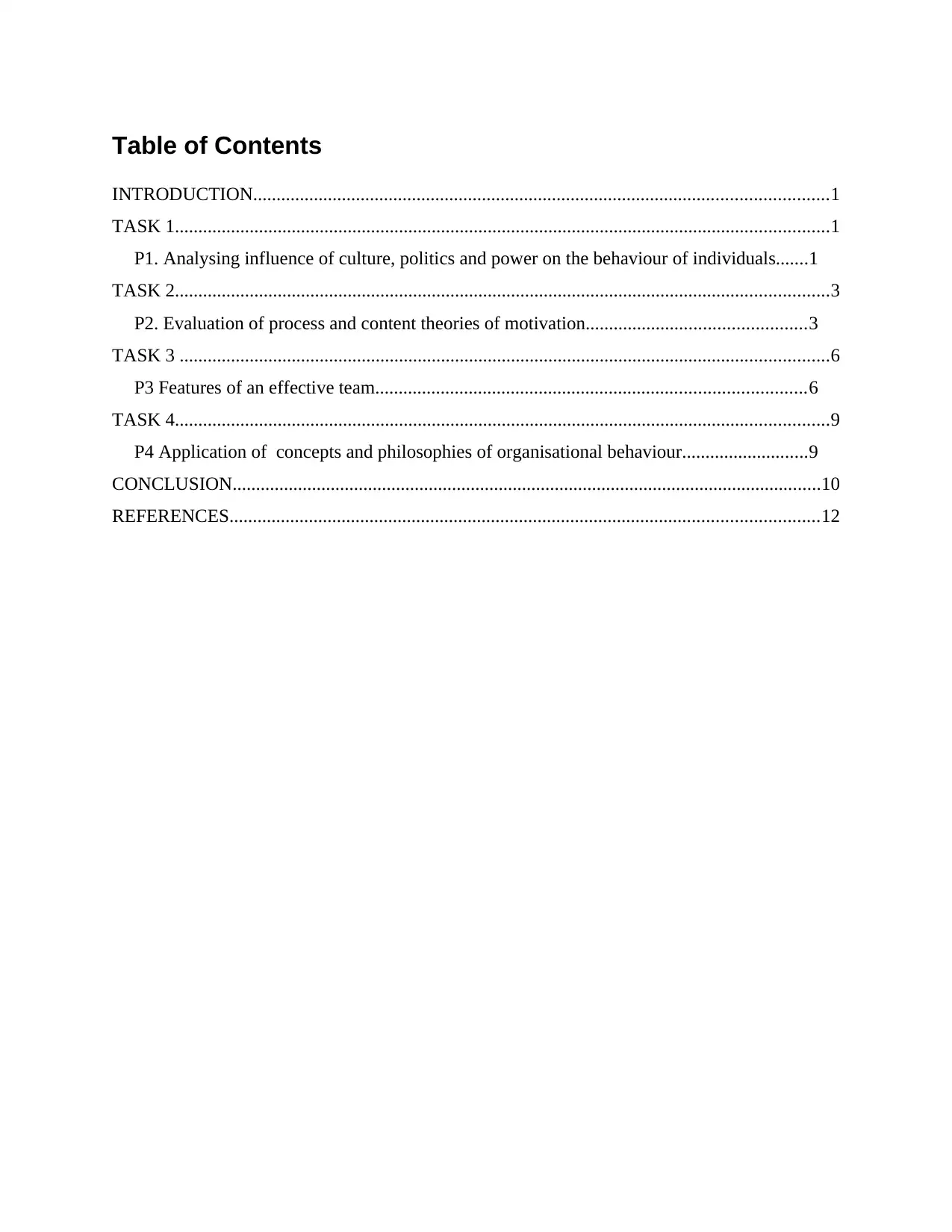
Table of Contents
INTRODUCTION...........................................................................................................................1
TASK 1............................................................................................................................................1
P1. Analysing influence of culture, politics and power on the behaviour of individuals.......1
TASK 2............................................................................................................................................3
P2. Evaluation of process and content theories of motivation...............................................3
TASK 3 ...........................................................................................................................................6
P3 Features of an effective team............................................................................................6
TASK 4............................................................................................................................................9
P4 Application of concepts and philosophies of organisational behaviour...........................9
CONCLUSION..............................................................................................................................10
REFERENCES..............................................................................................................................12
INTRODUCTION...........................................................................................................................1
TASK 1............................................................................................................................................1
P1. Analysing influence of culture, politics and power on the behaviour of individuals.......1
TASK 2............................................................................................................................................3
P2. Evaluation of process and content theories of motivation...............................................3
TASK 3 ...........................................................................................................................................6
P3 Features of an effective team............................................................................................6
TASK 4............................................................................................................................................9
P4 Application of concepts and philosophies of organisational behaviour...........................9
CONCLUSION..............................................................................................................................10
REFERENCES..............................................................................................................................12
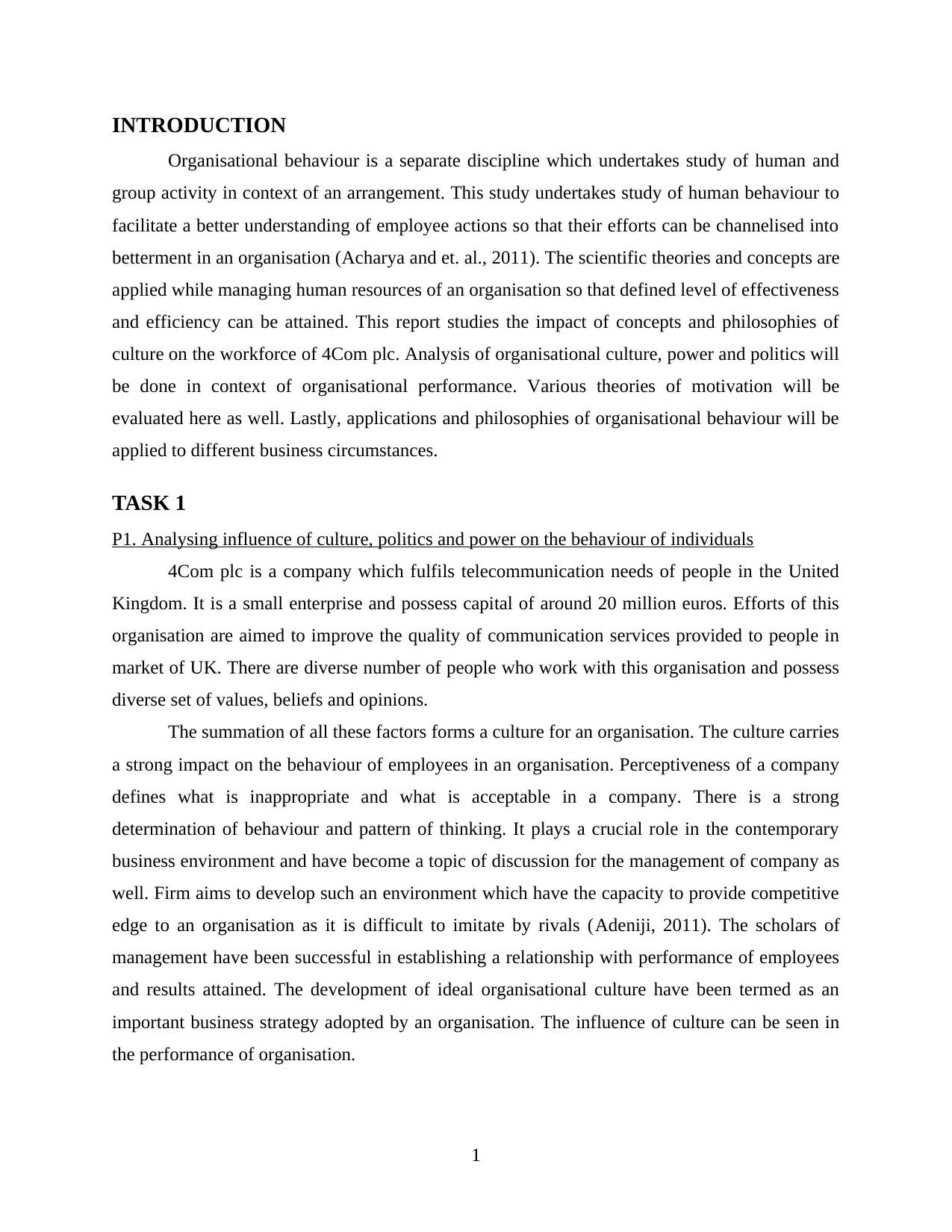
INTRODUCTION
Organisational behaviour is a separate discipline which undertakes study of human and
group activity in context of an arrangement. This study undertakes study of human behaviour to
facilitate a better understanding of employee actions so that their efforts can be channelised into
betterment in an organisation (Acharya and et. al., 2011). The scientific theories and concepts are
applied while managing human resources of an organisation so that defined level of effectiveness
and efficiency can be attained. This report studies the impact of concepts and philosophies of
culture on the workforce of 4Com plc. Analysis of organisational culture, power and politics will
be done in context of organisational performance. Various theories of motivation will be
evaluated here as well. Lastly, applications and philosophies of organisational behaviour will be
applied to different business circumstances.
TASK 1
P1. Analysing influence of culture, politics and power on the behaviour of individuals
4Com plc is a company which fulfils telecommunication needs of people in the United
Kingdom. It is a small enterprise and possess capital of around 20 million euros. Efforts of this
organisation are aimed to improve the quality of communication services provided to people in
market of UK. There are diverse number of people who work with this organisation and possess
diverse set of values, beliefs and opinions.
The summation of all these factors forms a culture for an organisation. The culture carries
a strong impact on the behaviour of employees in an organisation. Perceptiveness of a company
defines what is inappropriate and what is acceptable in a company. There is a strong
determination of behaviour and pattern of thinking. It plays a crucial role in the contemporary
business environment and have become a topic of discussion for the management of company as
well. Firm aims to develop such an environment which have the capacity to provide competitive
edge to an organisation as it is difficult to imitate by rivals (Adeniji, 2011). The scholars of
management have been successful in establishing a relationship with performance of employees
and results attained. The development of ideal organisational culture have been termed as an
important business strategy adopted by an organisation. The influence of culture can be seen in
the performance of organisation.
1
Organisational behaviour is a separate discipline which undertakes study of human and
group activity in context of an arrangement. This study undertakes study of human behaviour to
facilitate a better understanding of employee actions so that their efforts can be channelised into
betterment in an organisation (Acharya and et. al., 2011). The scientific theories and concepts are
applied while managing human resources of an organisation so that defined level of effectiveness
and efficiency can be attained. This report studies the impact of concepts and philosophies of
culture on the workforce of 4Com plc. Analysis of organisational culture, power and politics will
be done in context of organisational performance. Various theories of motivation will be
evaluated here as well. Lastly, applications and philosophies of organisational behaviour will be
applied to different business circumstances.
TASK 1
P1. Analysing influence of culture, politics and power on the behaviour of individuals
4Com plc is a company which fulfils telecommunication needs of people in the United
Kingdom. It is a small enterprise and possess capital of around 20 million euros. Efforts of this
organisation are aimed to improve the quality of communication services provided to people in
market of UK. There are diverse number of people who work with this organisation and possess
diverse set of values, beliefs and opinions.
The summation of all these factors forms a culture for an organisation. The culture carries
a strong impact on the behaviour of employees in an organisation. Perceptiveness of a company
defines what is inappropriate and what is acceptable in a company. There is a strong
determination of behaviour and pattern of thinking. It plays a crucial role in the contemporary
business environment and have become a topic of discussion for the management of company as
well. Firm aims to develop such an environment which have the capacity to provide competitive
edge to an organisation as it is difficult to imitate by rivals (Adeniji, 2011). The scholars of
management have been successful in establishing a relationship with performance of employees
and results attained. The development of ideal organisational culture have been termed as an
important business strategy adopted by an organisation. The influence of culture can be seen in
the performance of organisation.
1
⊘ This is a preview!⊘
Do you want full access?
Subscribe today to unlock all pages.

Trusted by 1+ million students worldwide
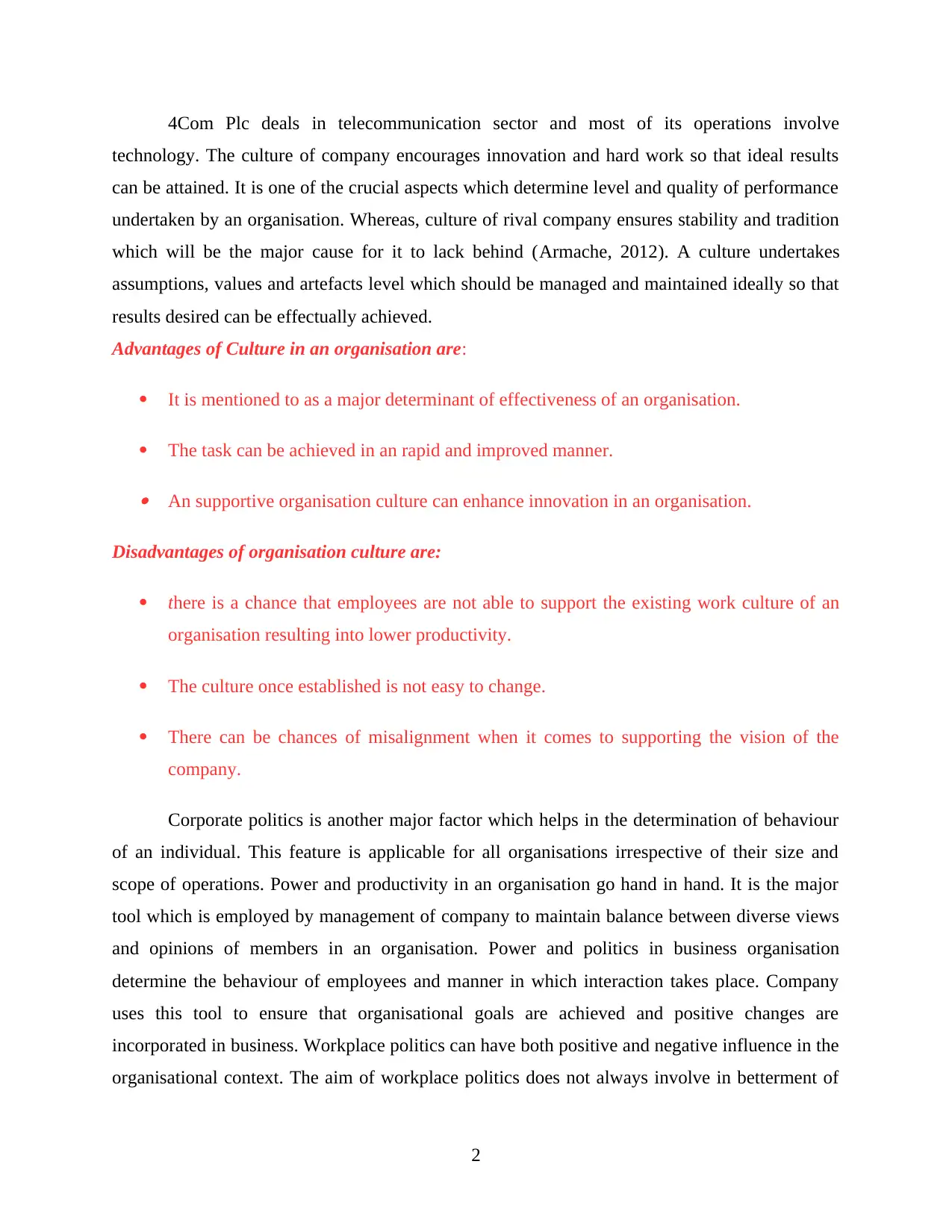
4Com Plc deals in telecommunication sector and most of its operations involve
technology. The culture of company encourages innovation and hard work so that ideal results
can be attained. It is one of the crucial aspects which determine level and quality of performance
undertaken by an organisation. Whereas, culture of rival company ensures stability and tradition
which will be the major cause for it to lack behind (Armache, 2012). A culture undertakes
assumptions, values and artefacts level which should be managed and maintained ideally so that
results desired can be effectually achieved.
Advantages of Culture in an organisation are:
It is mentioned to as a major determinant of effectiveness of an organisation.
The task can be achieved in an rapid and improved manner.
An supportive organisation culture can enhance innovation in an organisation.
Disadvantages of organisation culture are:
there is a chance that employees are not able to support the existing work culture of an
organisation resulting into lower productivity.
The culture once established is not easy to change.
There can be chances of misalignment when it comes to supporting the vision of the
company.
Corporate politics is another major factor which helps in the determination of behaviour
of an individual. This feature is applicable for all organisations irrespective of their size and
scope of operations. Power and productivity in an organisation go hand in hand. It is the major
tool which is employed by management of company to maintain balance between diverse views
and opinions of members in an organisation. Power and politics in business organisation
determine the behaviour of employees and manner in which interaction takes place. Company
uses this tool to ensure that organisational goals are achieved and positive changes are
incorporated in business. Workplace politics can have both positive and negative influence in the
organisational context. The aim of workplace politics does not always involve in betterment of
2
technology. The culture of company encourages innovation and hard work so that ideal results
can be attained. It is one of the crucial aspects which determine level and quality of performance
undertaken by an organisation. Whereas, culture of rival company ensures stability and tradition
which will be the major cause for it to lack behind (Armache, 2012). A culture undertakes
assumptions, values and artefacts level which should be managed and maintained ideally so that
results desired can be effectually achieved.
Advantages of Culture in an organisation are:
It is mentioned to as a major determinant of effectiveness of an organisation.
The task can be achieved in an rapid and improved manner.
An supportive organisation culture can enhance innovation in an organisation.
Disadvantages of organisation culture are:
there is a chance that employees are not able to support the existing work culture of an
organisation resulting into lower productivity.
The culture once established is not easy to change.
There can be chances of misalignment when it comes to supporting the vision of the
company.
Corporate politics is another major factor which helps in the determination of behaviour
of an individual. This feature is applicable for all organisations irrespective of their size and
scope of operations. Power and productivity in an organisation go hand in hand. It is the major
tool which is employed by management of company to maintain balance between diverse views
and opinions of members in an organisation. Power and politics in business organisation
determine the behaviour of employees and manner in which interaction takes place. Company
uses this tool to ensure that organisational goals are achieved and positive changes are
incorporated in business. Workplace politics can have both positive and negative influence in the
organisational context. The aim of workplace politics does not always involve in betterment of
2
Paraphrase This Document
Need a fresh take? Get an instant paraphrase of this document with our AI Paraphraser

business it sometimes aims for an individual to exercise more power in an organisation. The
person with power can sometimes keep his personal gains above organisational advantages.
Benefits of workplace politics are:
the most benefit which can be availed is that morale of employees can be boosted with
right application of workplace politics.
The indiscipline activities in an organisation can be resisted.
There can be a positive impact on the productivity of employees working with an
organisation.
Major disadvantages of office politics are:
this most important which can be seen is that office politics leads to distraction of
employees and focus on unproductive activities.
There can be conflicts in an organisation when people with different opinion clashes.
The politics in context of a company results in declining harmony and cooperation among
employees.
Power at the workplace is another crucial factor which determines manner in which
operations are carried out in an organisation (Bolino and et. al., 2013). Politics is manner adopted
through which a person aims to gain attention and are liked by influential people in an
organisation. The power can be categorised on many fronts such as legitimate, coercive and
informational grounds in an organisation. The person who carries a influence can impact the
functioning of business in the right manner. In a medium enterprises such as 4Com plc an
individual with power control all major operations of business.
Major advantages of power in an organisation are:
Power helps a leader in fulfilling task in the right manner through employees.
The right use of power can help in achievement of organisational as well as personal
goals of an individual with authority.
It can help in establishing balance between various behaviour and opinions of employees
so that productivity can be enhanced.
3
person with power can sometimes keep his personal gains above organisational advantages.
Benefits of workplace politics are:
the most benefit which can be availed is that morale of employees can be boosted with
right application of workplace politics.
The indiscipline activities in an organisation can be resisted.
There can be a positive impact on the productivity of employees working with an
organisation.
Major disadvantages of office politics are:
this most important which can be seen is that office politics leads to distraction of
employees and focus on unproductive activities.
There can be conflicts in an organisation when people with different opinion clashes.
The politics in context of a company results in declining harmony and cooperation among
employees.
Power at the workplace is another crucial factor which determines manner in which
operations are carried out in an organisation (Bolino and et. al., 2013). Politics is manner adopted
through which a person aims to gain attention and are liked by influential people in an
organisation. The power can be categorised on many fronts such as legitimate, coercive and
informational grounds in an organisation. The person who carries a influence can impact the
functioning of business in the right manner. In a medium enterprises such as 4Com plc an
individual with power control all major operations of business.
Major advantages of power in an organisation are:
Power helps a leader in fulfilling task in the right manner through employees.
The right use of power can help in achievement of organisational as well as personal
goals of an individual with authority.
It can help in establishing balance between various behaviour and opinions of employees
so that productivity can be enhanced.
3
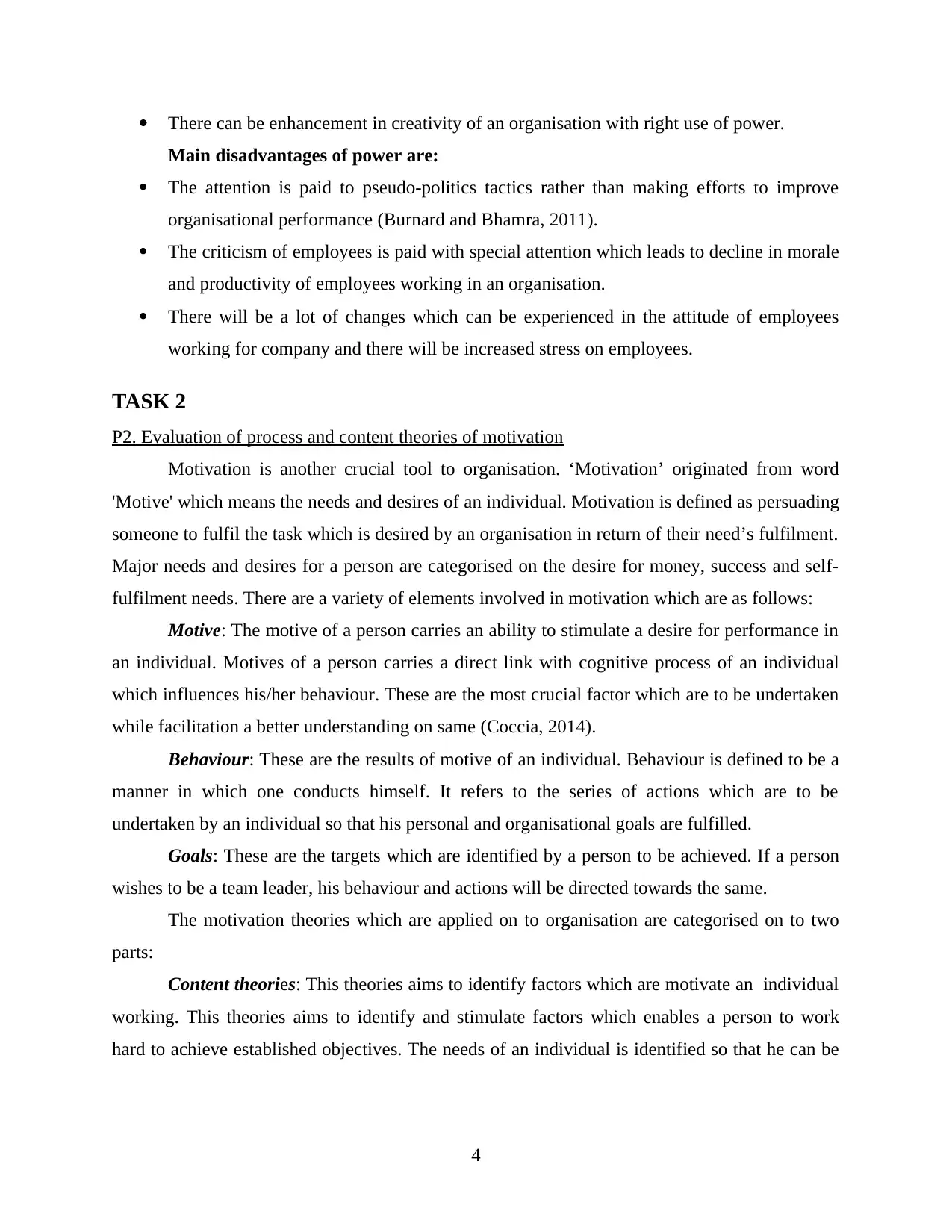
There can be enhancement in creativity of an organisation with right use of power.
Main disadvantages of power are:
The attention is paid to pseudo-politics tactics rather than making efforts to improve
organisational performance (Burnard and Bhamra, 2011).
The criticism of employees is paid with special attention which leads to decline in morale
and productivity of employees working in an organisation.
There will be a lot of changes which can be experienced in the attitude of employees
working for company and there will be increased stress on employees.
TASK 2
P2. Evaluation of process and content theories of motivation
Motivation is another crucial tool to organisation. ‘Motivation’ originated from word
'Motive' which means the needs and desires of an individual. Motivation is defined as persuading
someone to fulfil the task which is desired by an organisation in return of their need’s fulfilment.
Major needs and desires for a person are categorised on the desire for money, success and self-
fulfilment needs. There are a variety of elements involved in motivation which are as follows:
Motive: The motive of a person carries an ability to stimulate a desire for performance in
an individual. Motives of a person carries a direct link with cognitive process of an individual
which influences his/her behaviour. These are the most crucial factor which are to be undertaken
while facilitation a better understanding on same (Coccia, 2014).
Behaviour: These are the results of motive of an individual. Behaviour is defined to be a
manner in which one conducts himself. It refers to the series of actions which are to be
undertaken by an individual so that his personal and organisational goals are fulfilled.
Goals: These are the targets which are identified by a person to be achieved. If a person
wishes to be a team leader, his behaviour and actions will be directed towards the same.
The motivation theories which are applied on to organisation are categorised on to two
parts:
Content theories: This theories aims to identify factors which are motivate an individual
working. This theories aims to identify and stimulate factors which enables a person to work
hard to achieve established objectives. The needs of an individual is identified so that he can be
4
Main disadvantages of power are:
The attention is paid to pseudo-politics tactics rather than making efforts to improve
organisational performance (Burnard and Bhamra, 2011).
The criticism of employees is paid with special attention which leads to decline in morale
and productivity of employees working in an organisation.
There will be a lot of changes which can be experienced in the attitude of employees
working for company and there will be increased stress on employees.
TASK 2
P2. Evaluation of process and content theories of motivation
Motivation is another crucial tool to organisation. ‘Motivation’ originated from word
'Motive' which means the needs and desires of an individual. Motivation is defined as persuading
someone to fulfil the task which is desired by an organisation in return of their need’s fulfilment.
Major needs and desires for a person are categorised on the desire for money, success and self-
fulfilment needs. There are a variety of elements involved in motivation which are as follows:
Motive: The motive of a person carries an ability to stimulate a desire for performance in
an individual. Motives of a person carries a direct link with cognitive process of an individual
which influences his/her behaviour. These are the most crucial factor which are to be undertaken
while facilitation a better understanding on same (Coccia, 2014).
Behaviour: These are the results of motive of an individual. Behaviour is defined to be a
manner in which one conducts himself. It refers to the series of actions which are to be
undertaken by an individual so that his personal and organisational goals are fulfilled.
Goals: These are the targets which are identified by a person to be achieved. If a person
wishes to be a team leader, his behaviour and actions will be directed towards the same.
The motivation theories which are applied on to organisation are categorised on to two
parts:
Content theories: This theories aims to identify factors which are motivate an individual
working. This theories aims to identify and stimulate factors which enables a person to work
hard to achieve established objectives. The needs of an individual is identified so that he can be
4
⊘ This is a preview!⊘
Do you want full access?
Subscribe today to unlock all pages.

Trusted by 1+ million students worldwide
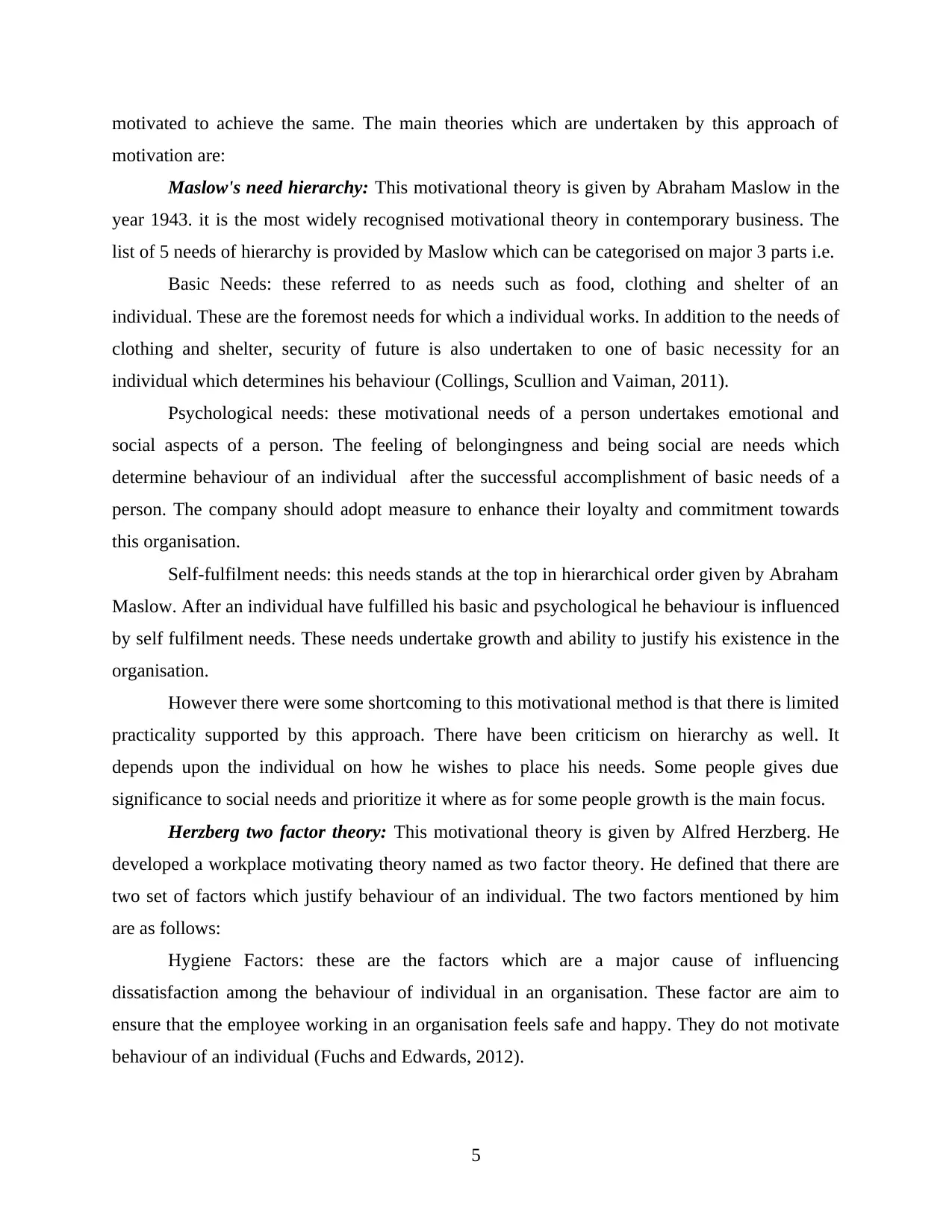
motivated to achieve the same. The main theories which are undertaken by this approach of
motivation are:
Maslow's need hierarchy: This motivational theory is given by Abraham Maslow in the
year 1943. it is the most widely recognised motivational theory in contemporary business. The
list of 5 needs of hierarchy is provided by Maslow which can be categorised on major 3 parts i.e.
Basic Needs: these referred to as needs such as food, clothing and shelter of an
individual. These are the foremost needs for which a individual works. In addition to the needs of
clothing and shelter, security of future is also undertaken to one of basic necessity for an
individual which determines his behaviour (Collings, Scullion and Vaiman, 2011).
Psychological needs: these motivational needs of a person undertakes emotional and
social aspects of a person. The feeling of belongingness and being social are needs which
determine behaviour of an individual after the successful accomplishment of basic needs of a
person. The company should adopt measure to enhance their loyalty and commitment towards
this organisation.
Self-fulfilment needs: this needs stands at the top in hierarchical order given by Abraham
Maslow. After an individual have fulfilled his basic and psychological he behaviour is influenced
by self fulfilment needs. These needs undertake growth and ability to justify his existence in the
organisation.
However there were some shortcoming to this motivational method is that there is limited
practicality supported by this approach. There have been criticism on hierarchy as well. It
depends upon the individual on how he wishes to place his needs. Some people gives due
significance to social needs and prioritize it where as for some people growth is the main focus.
Herzberg two factor theory: This motivational theory is given by Alfred Herzberg. He
developed a workplace motivating theory named as two factor theory. He defined that there are
two set of factors which justify behaviour of an individual. The two factors mentioned by him
are as follows:
Hygiene Factors: these are the factors which are a major cause of influencing
dissatisfaction among the behaviour of individual in an organisation. These factor are aim to
ensure that the employee working in an organisation feels safe and happy. They do not motivate
behaviour of an individual (Fuchs and Edwards, 2012).
5
motivation are:
Maslow's need hierarchy: This motivational theory is given by Abraham Maslow in the
year 1943. it is the most widely recognised motivational theory in contemporary business. The
list of 5 needs of hierarchy is provided by Maslow which can be categorised on major 3 parts i.e.
Basic Needs: these referred to as needs such as food, clothing and shelter of an
individual. These are the foremost needs for which a individual works. In addition to the needs of
clothing and shelter, security of future is also undertaken to one of basic necessity for an
individual which determines his behaviour (Collings, Scullion and Vaiman, 2011).
Psychological needs: these motivational needs of a person undertakes emotional and
social aspects of a person. The feeling of belongingness and being social are needs which
determine behaviour of an individual after the successful accomplishment of basic needs of a
person. The company should adopt measure to enhance their loyalty and commitment towards
this organisation.
Self-fulfilment needs: this needs stands at the top in hierarchical order given by Abraham
Maslow. After an individual have fulfilled his basic and psychological he behaviour is influenced
by self fulfilment needs. These needs undertake growth and ability to justify his existence in the
organisation.
However there were some shortcoming to this motivational method is that there is limited
practicality supported by this approach. There have been criticism on hierarchy as well. It
depends upon the individual on how he wishes to place his needs. Some people gives due
significance to social needs and prioritize it where as for some people growth is the main focus.
Herzberg two factor theory: This motivational theory is given by Alfred Herzberg. He
developed a workplace motivating theory named as two factor theory. He defined that there are
two set of factors which justify behaviour of an individual. The two factors mentioned by him
are as follows:
Hygiene Factors: these are the factors which are a major cause of influencing
dissatisfaction among the behaviour of individual in an organisation. These factor are aim to
ensure that the employee working in an organisation feels safe and happy. They do not motivate
behaviour of an individual (Fuchs and Edwards, 2012).
5
Paraphrase This Document
Need a fresh take? Get an instant paraphrase of this document with our AI Paraphraser
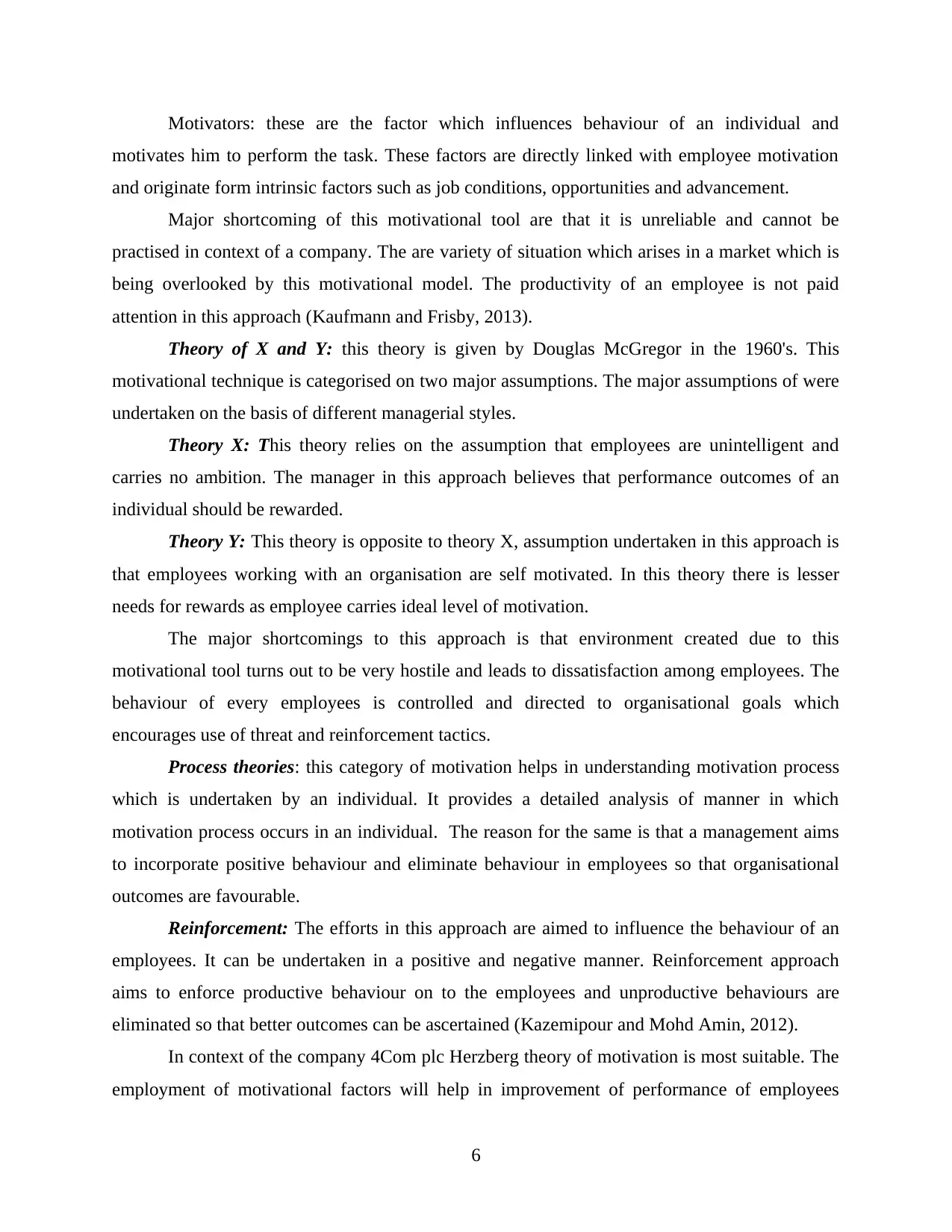
Motivators: these are the factor which influences behaviour of an individual and
motivates him to perform the task. These factors are directly linked with employee motivation
and originate form intrinsic factors such as job conditions, opportunities and advancement.
Major shortcoming of this motivational tool are that it is unreliable and cannot be
practised in context of a company. The are variety of situation which arises in a market which is
being overlooked by this motivational model. The productivity of an employee is not paid
attention in this approach (Kaufmann and Frisby, 2013).
Theory of X and Y: this theory is given by Douglas McGregor in the 1960's. This
motivational technique is categorised on two major assumptions. The major assumptions of were
undertaken on the basis of different managerial styles.
Theory X: This theory relies on the assumption that employees are unintelligent and
carries no ambition. The manager in this approach believes that performance outcomes of an
individual should be rewarded.
Theory Y: This theory is opposite to theory X, assumption undertaken in this approach is
that employees working with an organisation are self motivated. In this theory there is lesser
needs for rewards as employee carries ideal level of motivation.
The major shortcomings to this approach is that environment created due to this
motivational tool turns out to be very hostile and leads to dissatisfaction among employees. The
behaviour of every employees is controlled and directed to organisational goals which
encourages use of threat and reinforcement tactics.
Process theories: this category of motivation helps in understanding motivation process
which is undertaken by an individual. It provides a detailed analysis of manner in which
motivation process occurs in an individual. The reason for the same is that a management aims
to incorporate positive behaviour and eliminate behaviour in employees so that organisational
outcomes are favourable.
Reinforcement: The efforts in this approach are aimed to influence the behaviour of an
employees. It can be undertaken in a positive and negative manner. Reinforcement approach
aims to enforce productive behaviour on to the employees and unproductive behaviours are
eliminated so that better outcomes can be ascertained (Kazemipour and Mohd Amin, 2012).
In context of the company 4Com plc Herzberg theory of motivation is most suitable. The
employment of motivational factors will help in improvement of performance of employees
6
motivates him to perform the task. These factors are directly linked with employee motivation
and originate form intrinsic factors such as job conditions, opportunities and advancement.
Major shortcoming of this motivational tool are that it is unreliable and cannot be
practised in context of a company. The are variety of situation which arises in a market which is
being overlooked by this motivational model. The productivity of an employee is not paid
attention in this approach (Kaufmann and Frisby, 2013).
Theory of X and Y: this theory is given by Douglas McGregor in the 1960's. This
motivational technique is categorised on two major assumptions. The major assumptions of were
undertaken on the basis of different managerial styles.
Theory X: This theory relies on the assumption that employees are unintelligent and
carries no ambition. The manager in this approach believes that performance outcomes of an
individual should be rewarded.
Theory Y: This theory is opposite to theory X, assumption undertaken in this approach is
that employees working with an organisation are self motivated. In this theory there is lesser
needs for rewards as employee carries ideal level of motivation.
The major shortcomings to this approach is that environment created due to this
motivational tool turns out to be very hostile and leads to dissatisfaction among employees. The
behaviour of every employees is controlled and directed to organisational goals which
encourages use of threat and reinforcement tactics.
Process theories: this category of motivation helps in understanding motivation process
which is undertaken by an individual. It provides a detailed analysis of manner in which
motivation process occurs in an individual. The reason for the same is that a management aims
to incorporate positive behaviour and eliminate behaviour in employees so that organisational
outcomes are favourable.
Reinforcement: The efforts in this approach are aimed to influence the behaviour of an
employees. It can be undertaken in a positive and negative manner. Reinforcement approach
aims to enforce productive behaviour on to the employees and unproductive behaviours are
eliminated so that better outcomes can be ascertained (Kazemipour and Mohd Amin, 2012).
In context of the company 4Com plc Herzberg theory of motivation is most suitable. The
employment of motivational factors will help in improvement of performance of employees
6
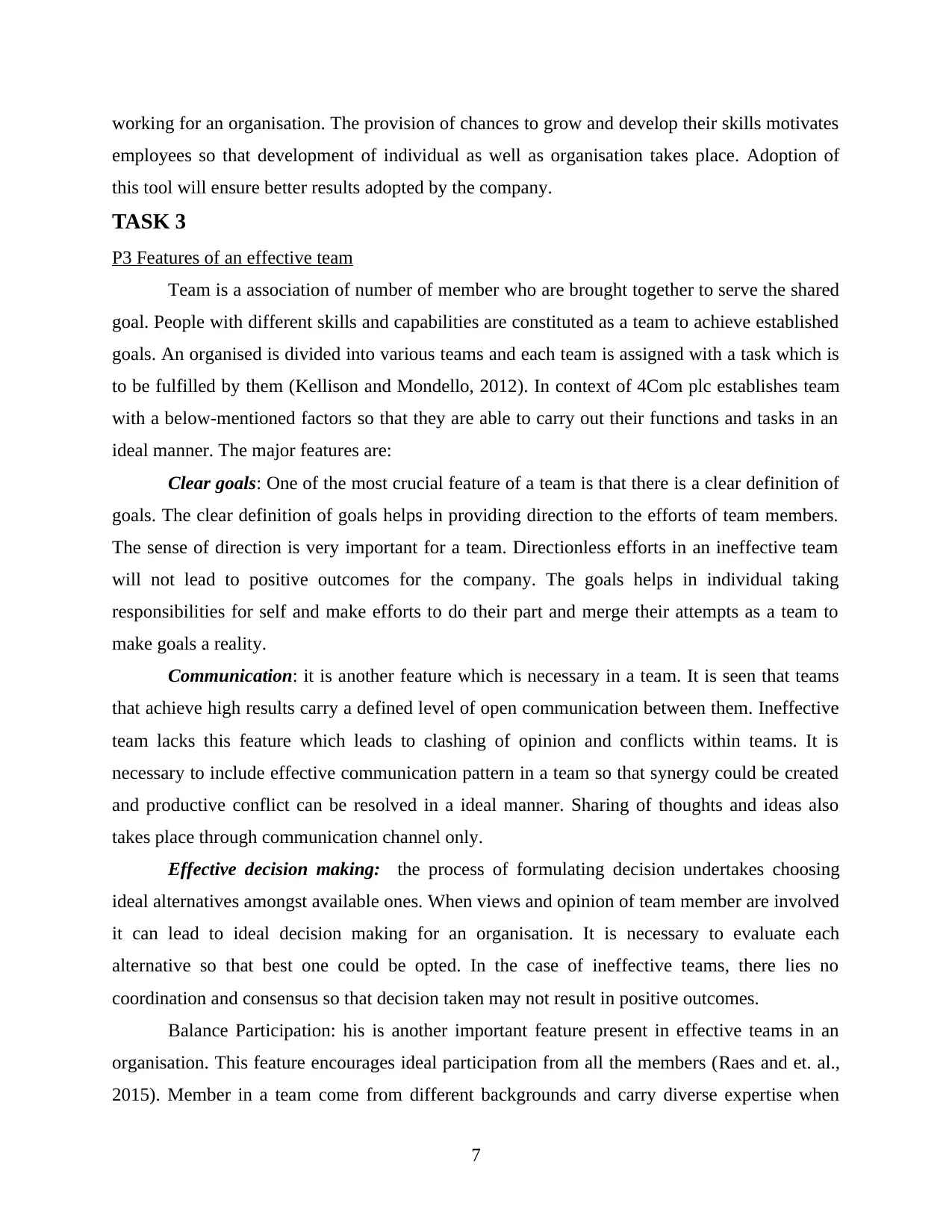
working for an organisation. The provision of chances to grow and develop their skills motivates
employees so that development of individual as well as organisation takes place. Adoption of
this tool will ensure better results adopted by the company.
TASK 3
P3 Features of an effective team
Team is a association of number of member who are brought together to serve the shared
goal. People with different skills and capabilities are constituted as a team to achieve established
goals. An organised is divided into various teams and each team is assigned with a task which is
to be fulfilled by them (Kellison and Mondello, 2012). In context of 4Com plc establishes team
with a below-mentioned factors so that they are able to carry out their functions and tasks in an
ideal manner. The major features are:
Clear goals: One of the most crucial feature of a team is that there is a clear definition of
goals. The clear definition of goals helps in providing direction to the efforts of team members.
The sense of direction is very important for a team. Directionless efforts in an ineffective team
will not lead to positive outcomes for the company. The goals helps in individual taking
responsibilities for self and make efforts to do their part and merge their attempts as a team to
make goals a reality.
Communication: it is another feature which is necessary in a team. It is seen that teams
that achieve high results carry a defined level of open communication between them. Ineffective
team lacks this feature which leads to clashing of opinion and conflicts within teams. It is
necessary to include effective communication pattern in a team so that synergy could be created
and productive conflict can be resolved in a ideal manner. Sharing of thoughts and ideas also
takes place through communication channel only.
Effective decision making: the process of formulating decision undertakes choosing
ideal alternatives amongst available ones. When views and opinion of team member are involved
it can lead to ideal decision making for an organisation. It is necessary to evaluate each
alternative so that best one could be opted. In the case of ineffective teams, there lies no
coordination and consensus so that decision taken may not result in positive outcomes.
Balance Participation: his is another important feature present in effective teams in an
organisation. This feature encourages ideal participation from all the members (Raes and et. al.,
2015). Member in a team come from different backgrounds and carry diverse expertise when
7
employees so that development of individual as well as organisation takes place. Adoption of
this tool will ensure better results adopted by the company.
TASK 3
P3 Features of an effective team
Team is a association of number of member who are brought together to serve the shared
goal. People with different skills and capabilities are constituted as a team to achieve established
goals. An organised is divided into various teams and each team is assigned with a task which is
to be fulfilled by them (Kellison and Mondello, 2012). In context of 4Com plc establishes team
with a below-mentioned factors so that they are able to carry out their functions and tasks in an
ideal manner. The major features are:
Clear goals: One of the most crucial feature of a team is that there is a clear definition of
goals. The clear definition of goals helps in providing direction to the efforts of team members.
The sense of direction is very important for a team. Directionless efforts in an ineffective team
will not lead to positive outcomes for the company. The goals helps in individual taking
responsibilities for self and make efforts to do their part and merge their attempts as a team to
make goals a reality.
Communication: it is another feature which is necessary in a team. It is seen that teams
that achieve high results carry a defined level of open communication between them. Ineffective
team lacks this feature which leads to clashing of opinion and conflicts within teams. It is
necessary to include effective communication pattern in a team so that synergy could be created
and productive conflict can be resolved in a ideal manner. Sharing of thoughts and ideas also
takes place through communication channel only.
Effective decision making: the process of formulating decision undertakes choosing
ideal alternatives amongst available ones. When views and opinion of team member are involved
it can lead to ideal decision making for an organisation. It is necessary to evaluate each
alternative so that best one could be opted. In the case of ineffective teams, there lies no
coordination and consensus so that decision taken may not result in positive outcomes.
Balance Participation: his is another important feature present in effective teams in an
organisation. This feature encourages ideal participation from all the members (Raes and et. al.,
2015). Member in a team come from different backgrounds and carry diverse expertise when
7
⊘ This is a preview!⊘
Do you want full access?
Subscribe today to unlock all pages.

Trusted by 1+ million students worldwide
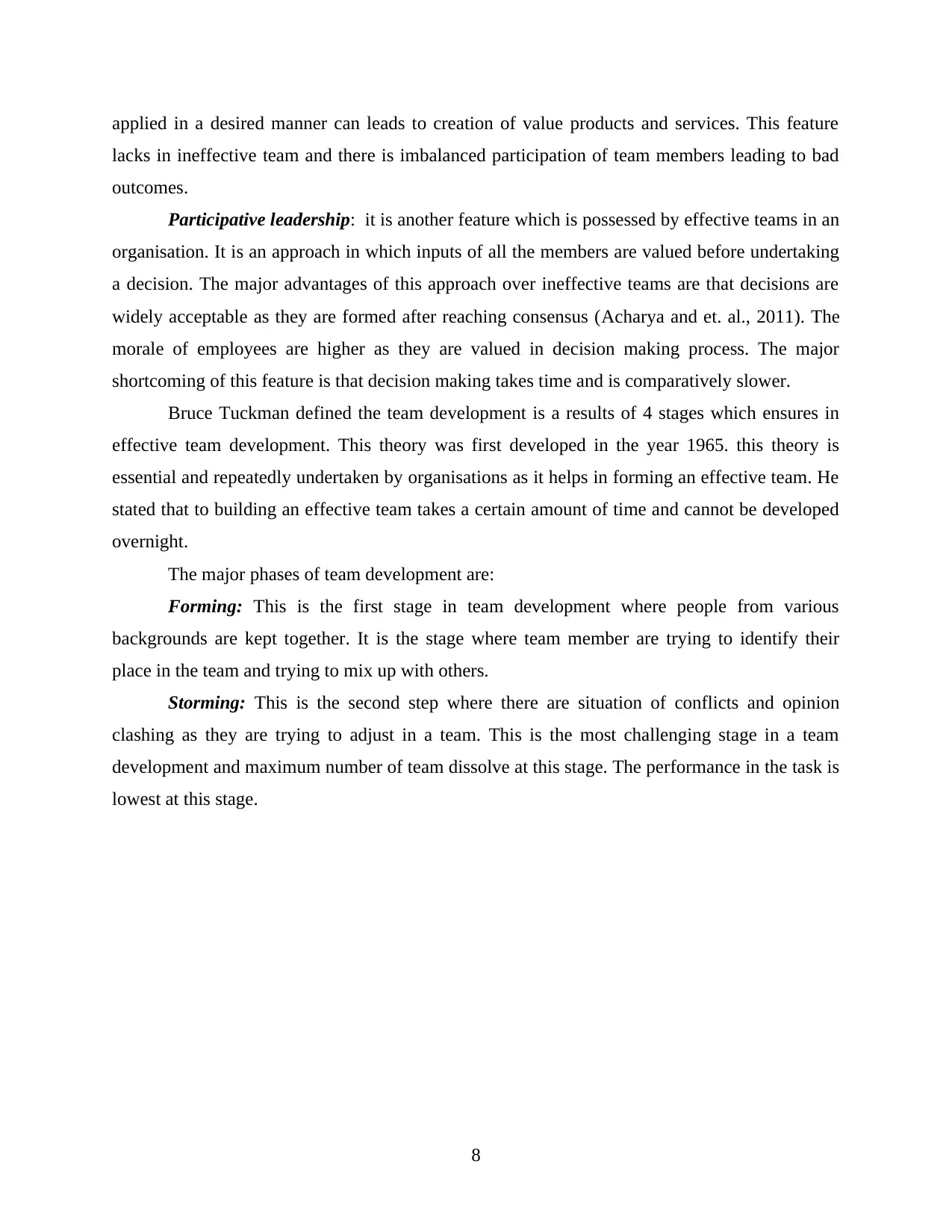
applied in a desired manner can leads to creation of value products and services. This feature
lacks in ineffective team and there is imbalanced participation of team members leading to bad
outcomes.
Participative leadership: it is another feature which is possessed by effective teams in an
organisation. It is an approach in which inputs of all the members are valued before undertaking
a decision. The major advantages of this approach over ineffective teams are that decisions are
widely acceptable as they are formed after reaching consensus (Acharya and et. al., 2011). The
morale of employees are higher as they are valued in decision making process. The major
shortcoming of this feature is that decision making takes time and is comparatively slower.
Bruce Tuckman defined the team development is a results of 4 stages which ensures in
effective team development. This theory was first developed in the year 1965. this theory is
essential and repeatedly undertaken by organisations as it helps in forming an effective team. He
stated that to building an effective team takes a certain amount of time and cannot be developed
overnight.
The major phases of team development are:
Forming: This is the first stage in team development where people from various
backgrounds are kept together. It is the stage where team member are trying to identify their
place in the team and trying to mix up with others.
Storming: This is the second step where there are situation of conflicts and opinion
clashing as they are trying to adjust in a team. This is the most challenging stage in a team
development and maximum number of team dissolve at this stage. The performance in the task is
lowest at this stage.
8
lacks in ineffective team and there is imbalanced participation of team members leading to bad
outcomes.
Participative leadership: it is another feature which is possessed by effective teams in an
organisation. It is an approach in which inputs of all the members are valued before undertaking
a decision. The major advantages of this approach over ineffective teams are that decisions are
widely acceptable as they are formed after reaching consensus (Acharya and et. al., 2011). The
morale of employees are higher as they are valued in decision making process. The major
shortcoming of this feature is that decision making takes time and is comparatively slower.
Bruce Tuckman defined the team development is a results of 4 stages which ensures in
effective team development. This theory was first developed in the year 1965. this theory is
essential and repeatedly undertaken by organisations as it helps in forming an effective team. He
stated that to building an effective team takes a certain amount of time and cannot be developed
overnight.
The major phases of team development are:
Forming: This is the first stage in team development where people from various
backgrounds are kept together. It is the stage where team member are trying to identify their
place in the team and trying to mix up with others.
Storming: This is the second step where there are situation of conflicts and opinion
clashing as they are trying to adjust in a team. This is the most challenging stage in a team
development and maximum number of team dissolve at this stage. The performance in the task is
lowest at this stage.
8
Paraphrase This Document
Need a fresh take? Get an instant paraphrase of this document with our AI Paraphraser
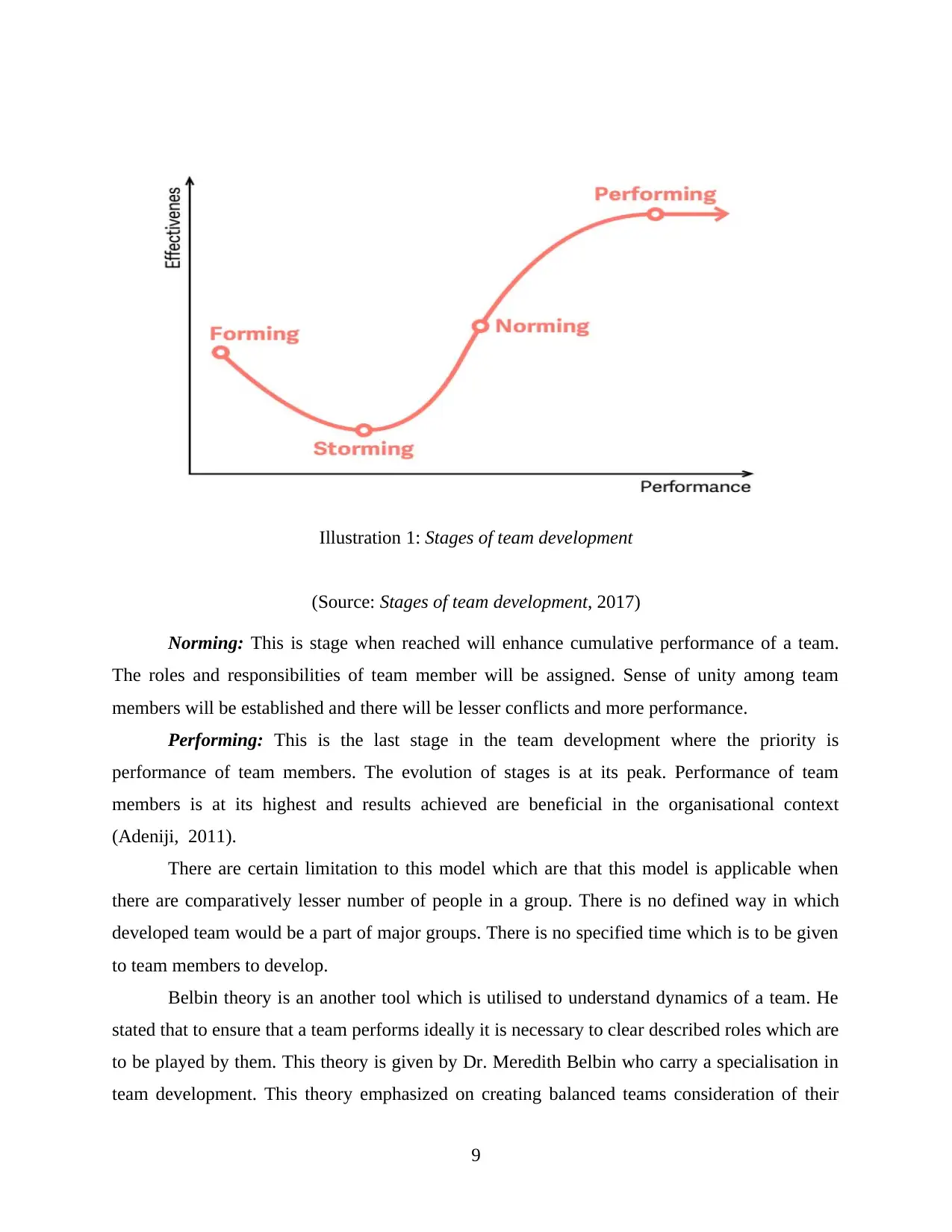
(Source: Stages of team development, 2017)
Norming: This is stage when reached will enhance cumulative performance of a team.
The roles and responsibilities of team member will be assigned. Sense of unity among team
members will be established and there will be lesser conflicts and more performance.
Performing: This is the last stage in the team development where the priority is
performance of team members. The evolution of stages is at its peak. Performance of team
members is at its highest and results achieved are beneficial in the organisational context
(Adeniji, 2011).
There are certain limitation to this model which are that this model is applicable when
there are comparatively lesser number of people in a group. There is no defined way in which
developed team would be a part of major groups. There is no specified time which is to be given
to team members to develop.
Belbin theory is an another tool which is utilised to understand dynamics of a team. He
stated that to ensure that a team performs ideally it is necessary to clear described roles which are
to be played by them. This theory is given by Dr. Meredith Belbin who carry a specialisation in
team development. This theory emphasized on creating balanced teams consideration of their
9
Illustration 1: Stages of team development
Norming: This is stage when reached will enhance cumulative performance of a team.
The roles and responsibilities of team member will be assigned. Sense of unity among team
members will be established and there will be lesser conflicts and more performance.
Performing: This is the last stage in the team development where the priority is
performance of team members. The evolution of stages is at its peak. Performance of team
members is at its highest and results achieved are beneficial in the organisational context
(Adeniji, 2011).
There are certain limitation to this model which are that this model is applicable when
there are comparatively lesser number of people in a group. There is no defined way in which
developed team would be a part of major groups. There is no specified time which is to be given
to team members to develop.
Belbin theory is an another tool which is utilised to understand dynamics of a team. He
stated that to ensure that a team performs ideally it is necessary to clear described roles which are
to be played by them. This theory is given by Dr. Meredith Belbin who carry a specialisation in
team development. This theory emphasized on creating balanced teams consideration of their
9
Illustration 1: Stages of team development
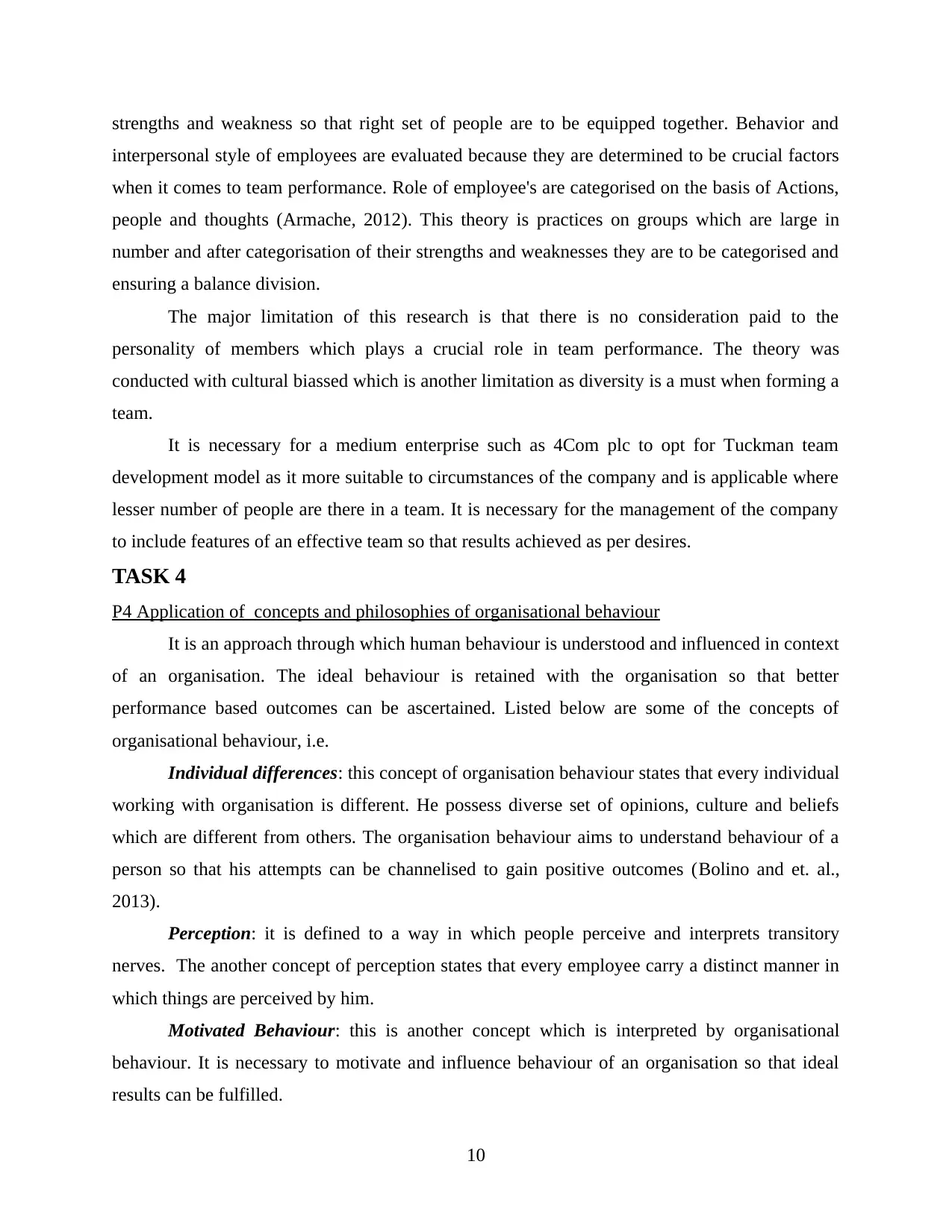
strengths and weakness so that right set of people are to be equipped together. Behavior and
interpersonal style of employees are evaluated because they are determined to be crucial factors
when it comes to team performance. Role of employee's are categorised on the basis of Actions,
people and thoughts (Armache, 2012). This theory is practices on groups which are large in
number and after categorisation of their strengths and weaknesses they are to be categorised and
ensuring a balance division.
The major limitation of this research is that there is no consideration paid to the
personality of members which plays a crucial role in team performance. The theory was
conducted with cultural biassed which is another limitation as diversity is a must when forming a
team.
It is necessary for a medium enterprise such as 4Com plc to opt for Tuckman team
development model as it more suitable to circumstances of the company and is applicable where
lesser number of people are there in a team. It is necessary for the management of the company
to include features of an effective team so that results achieved as per desires.
TASK 4
P4 Application of concepts and philosophies of organisational behaviour
It is an approach through which human behaviour is understood and influenced in context
of an organisation. The ideal behaviour is retained with the organisation so that better
performance based outcomes can be ascertained. Listed below are some of the concepts of
organisational behaviour, i.e.
Individual differences: this concept of organisation behaviour states that every individual
working with organisation is different. He possess diverse set of opinions, culture and beliefs
which are different from others. The organisation behaviour aims to understand behaviour of a
person so that his attempts can be channelised to gain positive outcomes (Bolino and et. al.,
2013).
Perception: it is defined to a way in which people perceive and interprets transitory
nerves. The another concept of perception states that every employee carry a distinct manner in
which things are perceived by him.
Motivated Behaviour: this is another concept which is interpreted by organisational
behaviour. It is necessary to motivate and influence behaviour of an organisation so that ideal
results can be fulfilled.
10
interpersonal style of employees are evaluated because they are determined to be crucial factors
when it comes to team performance. Role of employee's are categorised on the basis of Actions,
people and thoughts (Armache, 2012). This theory is practices on groups which are large in
number and after categorisation of their strengths and weaknesses they are to be categorised and
ensuring a balance division.
The major limitation of this research is that there is no consideration paid to the
personality of members which plays a crucial role in team performance. The theory was
conducted with cultural biassed which is another limitation as diversity is a must when forming a
team.
It is necessary for a medium enterprise such as 4Com plc to opt for Tuckman team
development model as it more suitable to circumstances of the company and is applicable where
lesser number of people are there in a team. It is necessary for the management of the company
to include features of an effective team so that results achieved as per desires.
TASK 4
P4 Application of concepts and philosophies of organisational behaviour
It is an approach through which human behaviour is understood and influenced in context
of an organisation. The ideal behaviour is retained with the organisation so that better
performance based outcomes can be ascertained. Listed below are some of the concepts of
organisational behaviour, i.e.
Individual differences: this concept of organisation behaviour states that every individual
working with organisation is different. He possess diverse set of opinions, culture and beliefs
which are different from others. The organisation behaviour aims to understand behaviour of a
person so that his attempts can be channelised to gain positive outcomes (Bolino and et. al.,
2013).
Perception: it is defined to a way in which people perceive and interprets transitory
nerves. The another concept of perception states that every employee carry a distinct manner in
which things are perceived by him.
Motivated Behaviour: this is another concept which is interpreted by organisational
behaviour. It is necessary to motivate and influence behaviour of an organisation so that ideal
results can be fulfilled.
10
⊘ This is a preview!⊘
Do you want full access?
Subscribe today to unlock all pages.

Trusted by 1+ million students worldwide
1 out of 16
Related Documents
Your All-in-One AI-Powered Toolkit for Academic Success.
+13062052269
info@desklib.com
Available 24*7 on WhatsApp / Email
![[object Object]](/_next/static/media/star-bottom.7253800d.svg)
Unlock your academic potential
Copyright © 2020–2025 A2Z Services. All Rights Reserved. Developed and managed by ZUCOL.





